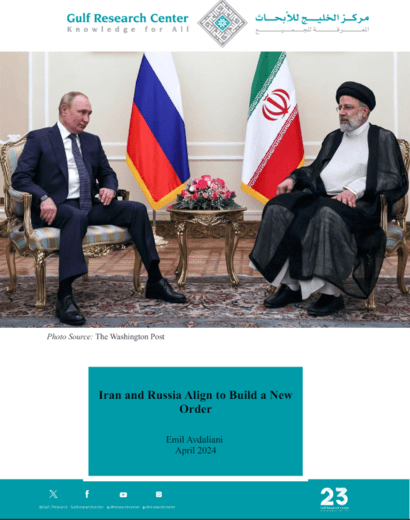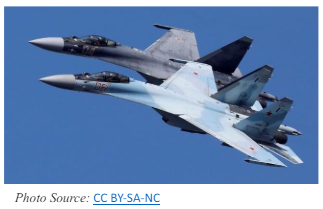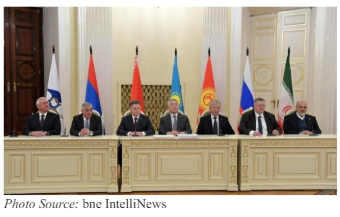
Since the end of the Cold War and the dissolution of the Soviet Union, Russia and Iran have maintained an ambivalent relationship. Their cooperation over the years has covered diverse areas of interest, ranging from economic and trade to military and defense. Yet the outbreak of the war in Ukraine in February 2022 changed this dynamic, impelling the two states to seek expansion of their bilateral relations in virtually every regard.
Iran and Russia were motivated by a shared opposition toward the collective West, especially the United States. Surely, Iran was more radical in its approach and, prior to 2022 and Russia’s invasion of Ukraine, Moscow maintained generally constructive ties with Washington. Moreover, Russia and Iran were fearful of each other’s geopolitical ambitions. Distrust ran high and Moscow overall was against the idea of seeing Iran acquire nuclear weapons or the expansion of its influence over the region. As of the start of the war in Ukraine, the two were far from establishing a formal alliance or even a comprehensive partnership.
The partnership is mostly symbiotic but there are arguments to be made that Iran has benefited from it more than Russia. While Iran was previously considered a less significant partner to Russia, the war with Ukraine pushed Moscow to re-evaluate its relationship with the Islamic Republic. Indeed, before the war, Russia’s geopolitical orientation remained mostly focused on the West due to existing bilateral trade and investment ties. While Moscow did also pursue relations with China, Iran, and other Eurasian actors following the annexation of Crimea in 2014, the Kremlin’s willingness to re-orient eastward was reserved. On the nuclear issue and the maintenance of the sanctions regime, Russia largely cooperated with Western countries against the Islamic Republic. Moreover, Iran was not a major trade partner to Russia and the latter was hesitant to pour investments into the Middle East country.
Therefore, it is safe to call the pre-2022 bilateral relations between Russia and Iran a limited partnership of convenience. Both reaped benefits to some extent, but the scope of the relationship remained significantly limited--a far cry from a strategic partnership. Moreover, Russia was seen as militarily superior in the South Caucasus, the Caspian Sea, and the Central Asian region--regions where the Islamic Republic traditionally aspires to present itself as a major geopolitical force. Even though the two cooperated in Syria starting in 2011 to preserve Bashar al-Assad in power, differences in achieving this goal were evident from 2015, when Russia entered the scene, causing tensions between Moscow and Tehran.
Nevertheless, despite these limitations, Moscow and Tehran always sought to expand bilateral relations. For instance, the Islamic Republic was increasingly seen by Moscow as a connecting space between Russia and the Indian Ocean with what later would become the International North-South Trade Corridor (INSTC).
Post-2022 Burgeoning of Bilateral Ties
In the wake of the Russian invasion of Ukraine, Iran grasped an opportunity emanating from Moscow’s growing isolation from the West and its push to pivot to the Middle East and Asia for trade and investment opportunities.
The growing collaboration between Moscow and Tehran also mirrors a shift in their geopolitical outlook, with both nations increasingly orienting towards Asia. For both countries, China’s rise along with collective Asia represents a major shift in global geopolitics. Moscow and Tehran have long believed that the time has come for the West’s pre-eminence to come to an end and the two countries could hasten the process by aligning closer with Beijing. Moreover, their pivot to Asia is not only a result of mutual opposition to the collective West. There are large trade and investment benefits which Moscow and Tehran seek from looking eastward. Yet the success of this approach is far from guaranteed. China has its own vision which does not squarely align with what Russia and Iran expect. Indeed, this has been proved in rather limited trade and especially investment ties between Iran and China and the latter’s unwillingness to fully support Russia because of potential sanctions and the fear of alienating the West.
The most obvious change to Iran-Russia ties has occurred in the military field where security collaboration between Tehran and Moscow has seen substantial growth over the past two years. Iran has historically been cautious about sending ballistic missiles to Russia, wary of repercussions from both the United States and European nations. However, the end of the UN arms embargo on Iran in October 2023 legally permitted Iran to export these missiles, reducing the risk of sanctions related to such transfers.
Following a meeting on January 24, 2024, between Nikolai Patrushev, Secretary of Russia’s Security Council, and IRGC Rear Admiral Ali-Akbar Ahmadian, reports have suggested that Iran is in the process of enlarging its support to Russia by supplying ballistic missiles, notably those from the Fateh-110 series, capable of hitting targets 300-700 km away. The alleged missile transfer is part of a broader trend of military cooperation that includes supplying ammunition, artillery shells, and drones to Russia, and even ongoing plans to establish a drone production facility in Russia. Reports from Russian and Iranian media also mentioned the delivery of Russian Yak-130 combat trainer aircraft to Iran and the potential use by Russia of a new Iranian kamikaze drone, Shahed-101 (and its variant, Shahed-107), which was actively used against U.S. bases in the Middle East in the past year. The drawn-out war in Ukraine and the relative missile shortages in Russia’s war effort also mean that the latter now is more interested in Iranian ballistic missiles.
There is more than just cooperation in the military realm. Despite Russia's long-standing resistance to giving Iran offensive cyber capabilities for fear that Iran might share or sell them, Russia has also likely provided Iran with communication surveillance capabilities and helped the Islamic Republic develop the ability to monitor and intercept mobile communications. Both have also expanded coordination to withstand international sanctions, shared sanctions evasion strategies, developed entire trade routes along Caspian shores and across the sea, and initiated cooperation in the development of artificial intelligence.

The above is not meant to suggest that is all is going to plan in Russia-Iran military ties. For instance, despite finalized deals for Russian Su35 jets and Mi-28 helicopters being announced, these agreements were later stated by politicians in Iran to be inconclusive, reflecting ongoing mistrust and the complexity of military and intelligence cooperation between the two countries. While the two countries collaborate closely, they maintain divergent views on various issues, including Syria and the South Caucasus, and Russia's hesitancy towards Iran's nuclear ambitions.
Yet, should Russia’s chances to win decisively in Ukraine decline, Moscow might further rethink its approach toward Iran’s requests for military training and advising and the supply of rotary and fixed-wing aircraft. And though Russia is now less circumspect toward selling high-tech weaponry to Iran, there are still limits to how far Moscow is willing to go. Here too Russia might reconsider the refusal to supply S400 air defense systems to the Islamic Republic. This military and security partnership is part of a larger cooperative framework highlighted by a free trade agreement signed between Iran and the Russian-led Eurasian Economic Union (EAEU) in late 2023, as well as the nearing completion of a comprehensive bilateral agreement, likely extending a 20-year cooperation treaty first signed in the early 2000s focused on military, economic, and political areas.

The deal with EAEU is significant in helping Russia to re-orient its trade from the EU toward other parts of the Eurasian region. For Iran, expanding commerce with the massive EAEU could help ease the pressure on the economy of the sanctioned state. Moreover, the Islamic Republic and Russia have also expanded cooperation in their banking systems and have claimed on numerous occasions to make trade payments in currencies other than the U.S. dollar.
Bilateral economic cooperation levels may not fully reflect official rhetoric, with bilateral trade dropping by 17 percent in 2023 to $4 billion from the $5 billion mark recorded in 2022. The problem is not so much in the decline of Iranian exports to Russia, but rather a steep decrease in Russian supplies to the Islamic Republic. More specifically, this decline attests to the overall dilemma that Russian businesses have experienced in selling their goods to Iran. The Islamic Republic has a different commercial culture which stands in contrast to Turkey or the UAE with which Russian entrepreneurs and traders have much in common. Russian traders have trouble reaching importers in Iran without intermediaries and have a hard time avoiding bureaucratic hurdles. Generally speaking, Russian businesses have not yet adjusted to consumer tastes in Iran, but rather prefer Gulf countries and Turkey. Still, Russian investments into Iran have grown and in 2023 Russia became the biggest source of FDI for the Islamic Republic with $2.76 billion out of the overall $4.2 billion.
Despite meager economic alignment, the unwritten geopolitical alliance between Iran and Russia remains robust, supported by a shared vision for a multipolar world order, opposition to Western dominance, and the creation of greater commercial and investment ties with Asia. Close ties between Russia and Iran are also being expanded through the swift implementation of the International NorthSouth Transport Corridor (INSTC) which aims to enhance connectivity across Eurasia. This ambitious project, initiated in the early 2000s by Russia, India, and Iran, aims to establish a 7,200 km transport route connecting India and Iran to Russia. Despite its slow progress and Russia's historical focus on east-west trade routes, the INSTC promises to significantly reduce transport times from India to Europe and reinvigorate trade through alternative paths bypassing traditional sea routes.
Recent geopolitical shifts, particularly the Ukraine conflict and Western sanctions on Russia, have injected new urgency into completing the INSTC. High-level visits and agreements between Russia, Iran, and Azerbaijan reflect a concerted effort to finalize the corridor, seen as a countermeasure to Western sanctions and a way to boost Eurasian trade.
The corridor, offering a shorter transit time compared to the Suez Canal route, has branches across the Caspian Sea and through the eastern seashore of Central Asia, aiming to become a key trade artery between Europe and Asia. However, the still incomplete Rasht-Astara railway section in Azerbaijan, crucial for linking Russia and Iran, remains a bottleneck hampered by U.S. sanctions, infrastructural challenges, and regional tensions.
Yet despite these obstacles, there is a concerted push to make the INSTC a reality, with the potential to reshape regional trade dynamics and offer a quicker route for goods transport between India and Europe, thereby strengthening Russian-Iranian economic ties amidst shifting geopolitical landscapes. In the most recent development, Russia and Iran reached an agreement in mid-2023 on the said railway section and Moscow pledged to invest in its construction.
Iran, with its trade and investment potential, surely cannot compensate Russia fully for its decline in trade with the Western countries, but it is critical geographically as a bridge for Russia to reach not only the Indian Ocean with India as a primary target, but also the wealthy Gulf, South of the Arabian Peninsula, and eastern Africa. Indeed, in 2023 Russia experimented by sending 36 containers to Saudi Arabia via the INSTC arriving first through the Incheh-Boroun border with Turkmenistan, destined for Iran’s southern port of Bandar Abbas and then to Jeddah on the Red Sea.
Moreover, Iran and Russia also have grown increasingly cooperative in their understanding of how to manage the regions that lie in between them. The idea of regionalism is nowadays quite fashionable in both capitals where politicians and analysts agree on the need to forestall the presence of non-regional actors. Here the target --the collective West-- is a convenient one, further boosting the convergence of ideas in Moscow and Tehran.
Looking Ahead
Ties between Iran and Russia date back to the late 16th century when both worked to oppose the expanding Ottoman Empire, but the closeness between them seen today is unprecedented. Despite Iranians' longstanding distrust of Russia, the post-Soviet period has seen Russia become a key arms and nuclear technology supplier to Iran, with both nations now increasingly cooperative in their efforts to bypass Western sanctions.
Presently the Iran-Russia relationship resembles a strategic partnership rather than a formal alliance, allowing for greater flexibility in navigating the international arena. This partnership is likely to continue strengthening, driven by shared opposition to Western policies and the evolving geopolitical landscape where the balance of power is shifting away from the West.
Russia and Iran’s unofficial alliance still has room for growth as each possesses significant resources and capabilities that the other needs. Moscow and Tehran still distrust each other when it comes to conflicting geopolitical interests from Syria to the South Caucasus and beyond. They also share different perspectives on the scope of bilateral cooperation, often leading to unmet expectations.
The unstated alliance between Russia and Iran benefits both parties, but Iran seems to have had a greater advantage. The war in Ukraine caused a relative level of isolation for Russia, pushing the country to embrace the Islamic Republic, which itself had been somewhat alienated on the global scene, allowing the latter to break out of its own period of isolation by mending its ties with its traditional rival, Saudi Arabia in March 2023--a rapprochement facilitated by Arab countries and China. Moreover, Iran has inadvertently emerged as a force to be reckoned with in the Black Sea basin. To be sure, its influence is still unmatched to traditional powers vis a vis trade, investments, and active diplomatic authority, but the alleged supply of drones and ballistic missiles has shifted the balance of power, especially for the war in Ukraine. Western powers now have to consider the Iranian factor when making calculations about future battlefield scenarios in Ukraine. Moreover, Western countries should even take into consideration how Iran is boosting Russia’s power to target other countries in Eastern Europe.
For Russia, relations with the Islamic Republic after the invasion of Ukraine constitute a major development in the history of their bilateral ties. Iranian drones and the alleged transfer of ballistic missiles keep Moscow’s war effort afloat, allow Russia to degrade infrastructure in Ukraine, and most of all, create a semblance of anti-Western solidarity between Eurasian states, which forces the EU and the U.S. to reconsider the idea of Russia’s isolation on military and economic fronts. In an age of relative chaos in Eurasian geopolitics, the momentum behind Iran and Russia’s strategic partnership will likely remain strong for the foreseeable future.
Emil Avdaliani is a professor of international relations at the European University in Tbilisi, Georgia, a scholar of Silk Roads and a nonresident fellow with the Gulf Research Center.
Yet, expanding ties reflect shifting geopolitical perspectives in the two capitals: both Russia and Iran have become more Asia-looking. Confrontation with the West pushed both to seek Asian vectors, coinciding with the rise of Asia as an effective economic and overall geopolitical counterpart to the West. This combination of long-term developments thus ensures the expanding partnership, also animated by the self-perception in Tehran and Moscow that they now serve as agents of the accelerated decline of the West on the global stage. For now, their relations will remain highly transactional, which means that each side is less obliged to wholeheartedly support the other if the benefits of doing so are too obscure. This type of relationship is not unique to the developments between Russia and Iran but rather, fits into the wider pattern of ties that have been gaining momentum across the entire Eurasian region. Indeed, Russia and China, China and Iran, Turkey and Russia, etc. all show how unofficial alliances/partnerships better serve each country’s geopolitical interests rather than iron-clad commitments. Amid a shifting global order, written commitments could present an obstacle. Moreover, the leaders in Iran and Russia also see official alliances as a relic of the Cold War period. In short, their preference lies in maintaining elastic relations.
The unstated alliance between Russia and Iran benefits both parties, but Iran seems to have had a greater advantage. The war in Ukraine caused a relative level of isolation for Russia, pushing the country to embrace the Islamic Republic, which itself had been somewhat alienated on the global scene, allowing the latter to break out of its own period of isolation by mending its ties with its traditional rival, Saudi Arabia in March 2023--a rapprochement facilitated by Arab countries and China. Moreover, Iran has inadvertently emerged as a force to be reckoned with in the Black Sea basin. To be sure, its influence is still unmatched to traditional powers vis a vis trade, investments, and active diplomatic authority, but the alleged supply of drones and ballistic missiles has shifted the balance of power, especially for the war in Ukraine. Western powers now have to consider the Iranian factor when making calculations about future battlefield scenarios in Ukraine. Moreover, Western countries should even take into consideration how Iran is boosting Russia’s power to target other countries in Eastern Europe.
For Russia, relations with the Islamic Republic after the invasion of Ukraine constitute a major development in the history of their bilateral ties. Iranian drones and the alleged transfer of ballistic missiles keep Moscow’s war effort afloat, allow Russia to degrade infrastructure in Ukraine, and most of all, create a semblance of anti-Western solidarity between Eurasian states, which forces the EU and the U.S. to reconsider the idea of Russia’s isolation on military and economic fronts. In an age of relative chaos in Eurasian geopolitics, the momentum behind Iran and Russia’s strategic partnership will likely remain strong for the foreseeable future.
Emil Avdaliani is a professor of international relations at the European University in Tbilisi, Georgia, a scholar of Silk Roads and a non-resident fellow with the Gulf Research Center.

